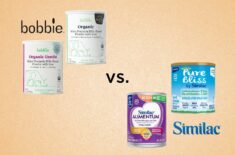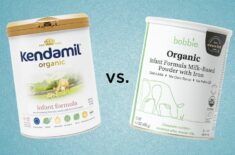Overview
Avocado is a “superfood” that’s a nutritious and delicious food to give your baby. It’s packed with nutrients, healthy fats, and minerals.
Studies show that avocado may reduce the risks of obesity, help improve gut health, and potentially prevent certain cancers, diabetes, inflammation, and cardiovascular diseases. (1)(2)(3)
Because it’s packed with MUFAs (monounsaturated fatty acids), antioxidants, and dietary fiber, avocado can also help with your baby’s growth and development. (2)
But is avocado ideal for baby-led weaning? Is avocado allowed for a six-month-old baby, and can you give it as your baby’s first food? Can a baby choke on avocado? How much should a six-month-old eat, and what other foods should you start with if you’re choosing baby-led weaning? Find our answers below.
Top Reasons To Serve Avocado To Your Baby
It’s Easy To Prepare
You don’t need to cook an avocado before serving it to your baby. Just peel and cut a ripe avocado to your desired size and shape, then give it to your child.
It’s soft enough to cut using a knife or your baby’s spoon and fork.
You can also use the ripe fruit to prepare a fruit shake, salad, or other baby food recipes.
It’s Delicious & Nutritious
Different kids prefer different foods, but avocado might be something that your baby might love.
Because of its versatility, it’s often considered a great first food for babies.
Don’t be too alarmed if you notice your child gagging while eating avocado or any food they taste for the first time. Gagging is a natural reflex action involving their tongue interacting with a foreign object or new taste.
If you’re doing baby-led weaning, simply continue offering your baby avocado slices until they become accustomed to its taste and texture.
Keep in mind that you will often need to introduce a single food several times before your baby takes to it. Keep at it, mama.
It Can Work With Different Feeding Styles
Avocado can be a good choice for baby-led weaning. It’s soft enough for you to cut into fun pieces and serve as finger food they can pick up and eat on their own.
Avocados can be soft and slippery, so the slices or cubes might easily fall off your baby’s hand.
Try coating an avocado slice with hemp seeds for added grip. Your baby might find their texture and softness interesting.
The fruit can also work with traditional spoon-feeding. Simply load up the avo on a spoon and allow your baby to self-feed.
Different Ways To Serve
Avocado is a versatile fruit that you can serve different ways, depending on your baby’s preferences or what type of feeding method you want to try.
It can be served mushy, as a fruit shake, guacamole, or in slices and cubes. You can even serve it along with sweet potato.
You can mash an avocado or make a smooth purée for your little one if you’re spoon-feeding.
For BLW (baby-led weaning), you can simply cut it up the way you want and give it to your child. You can also opt to add some gluten-free bread crumbs or hemp seed coating for texture.
Can A Baby Choke On Avocado?
Avocado isn’t considered a common choking hazard and can be a good option for your baby’s first food.
But make sure to cut it to suit your child’s age and needs. Note that any food can be a potential choking hazard, so always watch your child closely while they’re eating.
How Do You Cut Avocado For Baby-Led Weaning?
The cuts should be small enough for your child to self-feed:
- 6 to 9 months old – thick slices or large cubes, with or without coating
- 9 to 12 months old – strips or spears, with or without coating
- 12 to 24 months old – larger cuts or an avocado “boat” (cut avocado they can scoop with a spoon)
You can opt to give bigger pieces to younger children. They can hold it from one end and eat from the other.
You can also leave some peeling, so your child has something to hold that isn’t slippery. However, only do this for older children who know the difference between the soft fruit they can eat and the hard peeling they shouldn’t put in their mouth.
It’s possible that younger children haven’t mastered the pincer grasp yet (holding food or objects between their thumb and index finger). So, they might grab at food using their entire palm and put their entire hand to their mouths.
So, keep peeling off foods you give to baby-led weaning beginners.
Always watch out for possible choking hazards when serving your baby slices of avocado.
You can also talk to a registered dietitian or your baby’s pediatrician for their recommendations on how you can prepare your child’s food for baby-led weaning.
Benefits Of Avocado For Baby
It’s good to encourage your baby to eat avocado because it offers many possible benefits.
It may have antibacterial and antimicrobial properties. Studies have shown that this superfood might prevent certain medical conditions: (1)(2)(3)
- Obesity
- Certain cancers
- Diabetes
- Inflammation
- Cardiovascular diseases
Clinical trials show that it can increase the number of good bacteria in the tummy, improving gut health and supporting smoother digestion. (2)
This fruit is packed with nutrients that can also help promote your baby’s growth and development.
It contains the following:
- Monounsaturated fats or healthy fats
- Antioxidants
- Dietary fibers
- Vitamin E
- Riboflavin
- Vitamin B6
- Folate
- Lutein
- Potassium
- Oleic acid
- Vitamin C
- Thiamin
- Niacin
Is Avocado A Common Allergen?
You can let your baby eat avocado because it’s not a known allergen.
Although it’s uncommon, there have been reports of people experiencing allergic reactions after eating this fruit. (4)
Check with your pediatrician before giving your child any new food.
Can I Give My Baby Avocado As First Food?
Yes. You can choose avocado as your baby’s first food.
You can give puréed or mashed avocado to your baby. Another option is to give it as cuts or slices if you’re doing baby-led weaning.
When Can Babies Eat Avocado?
If your baby is showing signs of readiness you can try offering them avocado from 4-6 months.
Can I Feed My 4 Month Old Baby Avocado?
Yes, but only if your baby is ready for solid foods.
Check for the following signs of readiness for baby food before introducing your child to solids:
- They can sit without any support.
- They have head control or can hold their neck and head upright and steady.
- They put objects in their mouths.
- They show interest or desire for food, such as leaning forward or opening their mouth upon seeing food.
- They no longer have the tongue-thrust reflex (sticking tongue out to push food or objects from their mouth).
- They can transfer food to the back of their mouth.
Still, ask your child’s pediatrician before starting them on solids.
Can Babies Eat Avocado At 5 Months?
Yes, but make sure they’re ready for solids by checking for signs of readiness mentioned above.
Avocado has a soft texture that may be easy for your baby to chew, swallow, and digest.
Is Avocado Allowed For A 6-Month-Old Baby?
Yes. If they haven’t already started earlier, babies are typically ready for solid foods when they’re six months old. You can start giving them foods like avocado.
Note that premature babies might need a little more time because their development may be delayed. Some parents might notice that their premature children can be ready for their first food around six months from their original due date.
How To Let Babies Self-Feed Avocado Purée
You can also let your child try purées in BLW. Here are some ways they can self-feed purées:
- Put the avocado purée directly on your child’s food tray and let them dip their fingers into it. You can also model dipping and putting your fingers in your mouth.
- Another good option is to put some preloaded spoons on the plate. Let them decide which spoon to pick. But it might be difficult, especially if they still don’t know how to hold a spoon.
- You can also offer avocado purées or guacamole as a dip for their finger foods. They can dip their carrot stick in an avocado purée.
- Or you can put avocado purée on toast.
Baby-Led Weaning Recipes For Avocado
There are different ways to prepare avocado for baby-led weaning.
Avocado Slices: Without Coating
Ingredients
- One ripe avocado
- 1 tsp lemon juice
Preparation Instructions
- Cut the avocado in half.
- Remove the seed.
- Peel it or scoop out the soft flesh.
- Cut to your desired size and shape. You might even create fun shapes for your child to enjoy picking up these finger foods.
- Lightly mix the lemon juice. It will help keep your avocado cuts from becoming discolored.
You can opt to keep some of the peelings at the bottom of your avocado spears or strips. These can help make the food less slippery for them to hold.
Avocado Slices: Coated
Ingredients
- One ripe avocado
- 1 tsp lemon juice
- Coating materials such as gluten-free bread crumbs or crushed gluten-free baby puffs
Preparation Instructions
- Prepare the avocado in the same manner as the recipe above.
- Add a layer of the coating.
Avocado Toast
Ingredients
- One half of a ripe avocado
- Bread slices (opt for bread without added sugar, gluten, honey, and nuts)
- Other toppings, such as hard-boiled egg sliced into small pieces
Preparation Instructions
- Scoop the flesh from the sliced avocado; place it in a small bowl.
- Lightly mash the avocado.
- Get some bread slices and toast the bread to your desired texture; spread the mashed avocado.
- Add the other toppings.
- Toast.
It’s important to make sure the toast has cooled down before giving it to your baby. Double-check its temperature to make sure it’s safe.
Other Avocado Recipes
You can also try the following recipes to complement baby-led weaning with soft foods.
In serving these soft solids, you can opt to let your child scoop them with bare hands or a spoon to self-feed.
Avocado Purée With Banana
Ingredients
- One ripe avocado
- One banana
- 2-3 tbsp of baby formula, breast milk, or water
Preparation Instructions
- Cut the avocado.
- Remove the seed.
- Scoop the soft flesh into a blender or food processor.
- Peel the banana and add it to the avocado.
- Add the baby formula, breast milk, or water.
- Turn on the food processor or blender. Adjust the liquids until you achieve your desired consistency.
You can opt for a creamy texture or use fewer liquids for a thicker purée (for older toddlers).
Guacamole Recipe
There are different ways to prepare guacamole, including with jalapeno peppers. But you should keep those spicy ingredients out of your baby’s food.
You can try this kid-friendly recipe instead:
Ingredients
- Two ripe avocados
- 1 tsp lemon juice or 1/4 lime
- 1 tsp minced cilantro (aka coriander)
- 12 pcs cherry tomatoes, chopped very well
- 1 tbsp extra-virgin olive oil
Preparation Instructions
- Cut the avocados in half.
- Remove the seeds. Scoop the soft fruit into a bowl.
- Mince the cherry tomatoes. Add these to the avocado in the bowl.
- Mix in the rest of the ingredients.
- Mash all these ingredients together.
If you want a soft, creamy texture, you can also use a food processor to blend these ingredients for your guacamole.
You can pair this guacamole recipe with strips of cucumber slices, chicken, or meat but make sure these other foods are cooked until tender.
But you should test these added items before serving them to your baby to avoid choking hazards.
Food Preparation & Feeding Equipment
- Food processor or blender
- Knife (keep out of children’s reach)
- A high chair with a safety strap
- Food-grade silicone baby bowl and utensils
FAQs
How Much Avocado Should A 6-Month-Old Eat?
In baby-led weaning, your baby determines how much they eat.
Typically, the serving size for adults is half an avocado fruit. Your child might opt to eat as much as that, but it’s likely that they’ll only eat a very little amount, especially if they’re still new to solids.
If you want a variety of foods per meal, you can also opt to give your baby just a few slices or cuts with other foods they can choose from.
What Foods Should I Start With For Baby Led Weaning?
There are no specific rules on your baby’s first foods, however, common options can include:
- Avocado
- Bananas
- Ripe mangoes
- Steamed broccoli florets
- Cooked sweet potatoes
- Chicken or meat strips (cooked tender)
Do I Need To Cook Avocado For My Baby?
No. Avocado is an easy-to-prepare food that doesn’t require cooking. But make sure you pick a ripe avocado.
How To Check If An Avocado Is Ripe?
A darker peel can mean an avocado is ripe, but you can press lightly on the fruit if you’re unsure. It should be soft to touch but also not mushy. A mushy uncut fruit is likely already overripe.
Putting the avocado in the fridge can slow the ripening process, but placing them next to bananas in a fruit bowl may speed it up.
Can Babies Eat Avocado Every Day?
Yes. Like most fruits and vegetables, avocado can be safe as an everyday food. But because it’s a seasonal fruit, it might not be available the entire year.
How Long Can Avocado Baby Foods Last?
Expiry dates will depend on the recipe and how your baby food was prepared. But typically, avocado baby foods can last 1-2 days in the fridge.
Mashed avocado or purées can last up to two months in the freezer. Make sure to add some lime or lemon juice to prevent discoloration.
Commercial baby foods like Little Spoon Avocado Green Apple Broccoli Spirulina may last up to three months in the freezer.
But these expiry dates are just best estimates. Make sure to check for signs of spoilage before giving any food to your baby.
How To Make Avocado Less Slippery To Hold
- Leave the peel at the bottom (only for older toddlers).
- Add hemp seeds, gluten-free bread crumbs, desiccated coconut, or other coatings.
Baby-Led Weaning Feeding Tips
Follow Your Baby’s Lead
In baby-led weaning, your baby is in control. You can simply put the food on the tray of their high chair and let them pick whatever they want to eat.
Don’t force your baby to eat more.
Try Some Spices Or Seasoning
These can help make your baby’s food more interesting. But make sure to avoid excess sodium, chili, and other spicy seasonings.
REFERENCES
(1) https://www.ncbi.nlm.nih.gov/pmc/articles/PMC6471050/
(2) https://pubmed.ncbi.nlm.nih.gov/32805028/
(3) https://www.ncbi.nlm.nih.gov/pmc/articles/PMC6826385/
(4) https://pubmed.ncbi.nlm.nih.gov/8566736/












